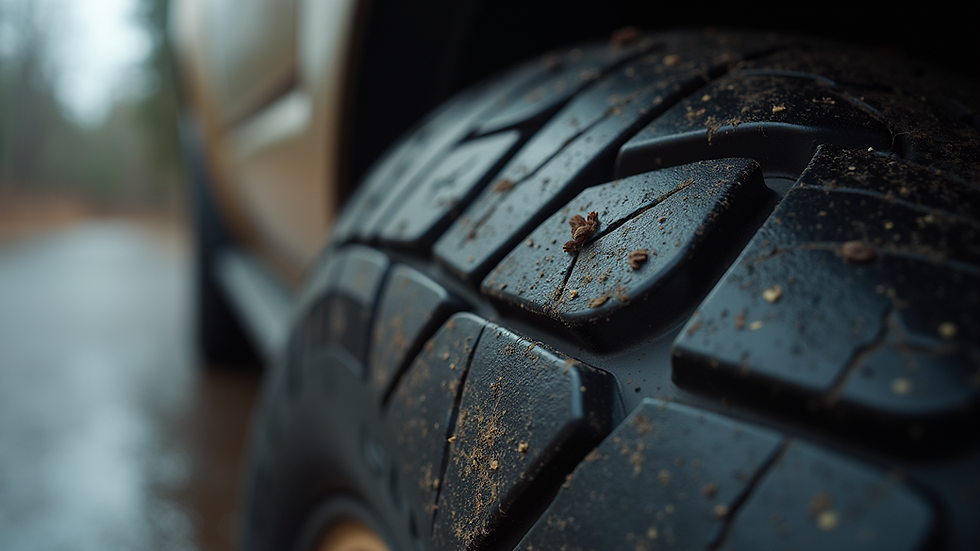Understanding Tire Age and Wear: When to Replace Your Tires
- Michael Rizk
- Sep 1
- 3 min read
Tires are vital to vehicle safety and performance, yet they often go unnoticed until problems arise. Most drivers do not realize that tires can wear out due to age and environmental factors, even if they seem to have enough tread. In this post, we will discuss what contributes to tire aging and wear, how to evaluate the condition of your tires, and when it’s time to make a replacement.
The Importance of Tire Maintenance
Regular tire maintenance is essential for safety and performance. With tires being the only point of contact between your vehicle and the road, their condition directly affects traction, handling, and braking. Neglecting tire upkeep may lead to:
Decreased performance
Higher fuel consumption
An increased risk of accidents
For example, studies show that under-inflated tires can increase fuel costs by as much as 3% per each 1 psi decrease in pressure. Monitoring tire pressure and condition regularly can not only enhance your safety but also save you money.
Understanding Tire Age
Tire age plays a significant role in determining when to replace your tires. Even if the tread looks fine, tires can break down over time due to factors like UV exposure and fluctuations in temperature and humidity.
Manufacturers generally recommend replacing tires every six years, regardless of tread condition. However, particular signs of aging may require attention sooner. For instance, if you notice cracks or bulges on the sidewall, these can indicate structural damage that warrants immediate replacement.

Signs of Tire Wear
Recognizing tire wear signs is crucial for safe driving. Here are common indicators to watch out for:
Tread Depth: Tires rely on tread for traction. You can use the penny test to check tread depth. Insert a penny into the tread with Lincoln's head facing down. If you see the top of Lincoln's head, it's time for new tires.
Uneven Wear: If one side of your tire is significantly more worn than the other, it may indicate alignment issues or incorrect air pressure. Regular tire rotation can help prevent this.
Cracks and Bulges: Any visible cracks or bulges should raise alarm bells. These can lead to tire blowouts if not addressed promptly.
Vibration or Noise: If you feel unusual vibrations or hear strange noises while driving, it may signal tire problems. A professional inspection can help pinpoint the cause.

Factors Affecting Tire Longevity
Understanding what affects tire lifespan can help you make informed choices. Here are key factors:
Driving Habits: Aggressive driving behaviors, such as rapid acceleration or braking, can accelerate tire wear. Smooth driving can extend tire life significantly.
Road Conditions: Frequent driving on rough or unpaved roads can lead to increased wear. If this is common for you, consider investing in more durable tires designed for such conditions.
Climate: Extremes in temperature can impact tire performance. In hot conditions, tires may wear out faster; in cold conditions, traction might decrease.
Tire Quality: Investing in higher-quality tires can prove beneficial in the long run. Higher-quality tires often have better materials and manufacturing processes that enhance durability.
When to Replace Your Tires
Knowing when to replace your tires is key for maintaining safety. Consider these guidelines:
Tread Wear Indicator: Most tires come with built-in indicators. If the tread has worn down to these indicators, it is time to replace the tire.
Age of the Tire: Even if tread appears fine, replace tires generally every six years. Check the manufacturing date stamped on the tire's sidewall.
Visible Damage: If you see any cracks, bulges, or punctures, have them inspected by a professional. Damaged tires often need immediate replacement.
Frequent Air Loss: Regularly adding air to your tires may indicate a slow leak. Have the tires checked to see if they need replacing.

Prioritize Tire Maintenance for Your Safety
Understanding tire age and wear is crucial for safe driving. Regular inspections for signs of wear, knowledge about factors that influence longevity, and awareness of when to replace your tires can significantly enhance your driving experience.
By focusing on tire maintenance, you not only improve your vehicle's performance but also ensure your own safety and that of others on the road. Consult a professional if you're unsure about your tires' condition. Remember, safety starts with good tires!




Comments